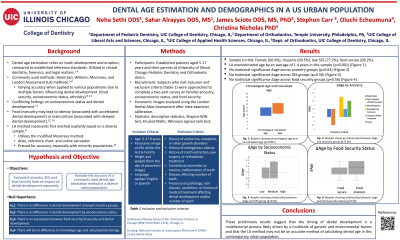Growth & Development
301 - Dental Age Estimation and Demographics in a US Urban Population

- NS
Neha Sethi, DDS
Pediatric Dental Resident
University of Illinois at Chicago, Chicago IL
University of Illinois at Chicago
Chicago, Illinois, United States - CN
Christina Nicholas, PhD
University of Illinois at Chicago
- SA
Sahar Alrayyes, DDS, MS
University of Illinois at Chicago
- MC
Michael Colvard, DDS, MTS, MS, PhD
University of Illinois at Chicago
- JS
James Sciote, DDS, MS, PhD
Temple University
- SC
Stephon L. Carr, B.S. Candidate
University of Illinois at Chicago
- OE
Oluchi C. Echeumuna, B.S. Kinesiology Candidate
University of Illinois at Chicago
- CN
Christina Nicholas, PhD
Associate Professor
University of Illinois at Chicago, College of Dentistry, Department of Orthodontics
Chicago, Illinois, United States 
Brittaney J. Hill, DDS, MS, MPH
Clinical Assistant Professor and Program Director, Department of Pediatric Dentistry
University of Illinois at Chicago
University of Illinois at Chicago
Chicago, Illinois, United States
Presenting Author(s)
Co-Author(s)
Research Mentor(s)
Program Director(s)
Purpose: Timing of dental development is a multifactorial process likely driven by a multitude of genetic and environmental factors. This study evaluates the impact of body mass index, ancestry, socioeconomic status, and geographic location on dental development, aiming to compare dental age estimation methods for a diverse urban population in Chicago, IL.
Methods: The subjects, aged 5-17, and their parents from the University of Illinois at Chicago Pediatric Dentistry and Orthodontic clinics completed a two-part questionnaire asking detailed questions about: ancestry, socioeconomic status, and food security. Radiographic analysis of recent panoramic images using the London Dental Atlas was conducted.
Results: Preliminary findings indicate consistent overestimation of chronological age (p < 0.001) by 1.4 years, with no significant variation in dental age by ancestry, socioeconomic status, or self-reported food insecurity. The sample, although preliminary, was unexpectedly more homogenous than expected based upon clinic demographics. Approximately 66% of respondents identified as Hispanic/Latinx and 76% falling into the low-income category. Among Latinx respondents, 76% specified Mexican or Mexican American as their ethnic background, and 29% reported some degree of food insecurity. Final data pending.
Conclusions: This project presents preliminary data from an investigation seeking to examine dental age across a diverse, contemporary sample of children. Lack of variation in relative dental development by ancestry and environmental variables may reflect the complexity of interaction among factors which contribute to timing of dental development. These results also indicate potential limitations to current dental age estimation methods when applied to diverse contemporary US populations.
Identify Supporting Agency and Grant Number:
Funding: NIJ Award #15PNIJ-22-GG-04433-RESS

.jpg)